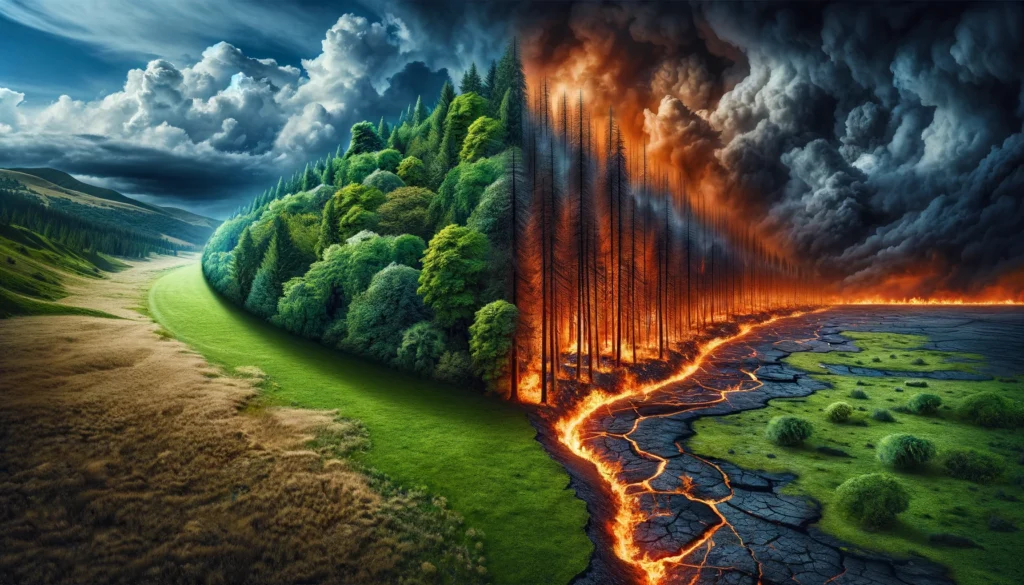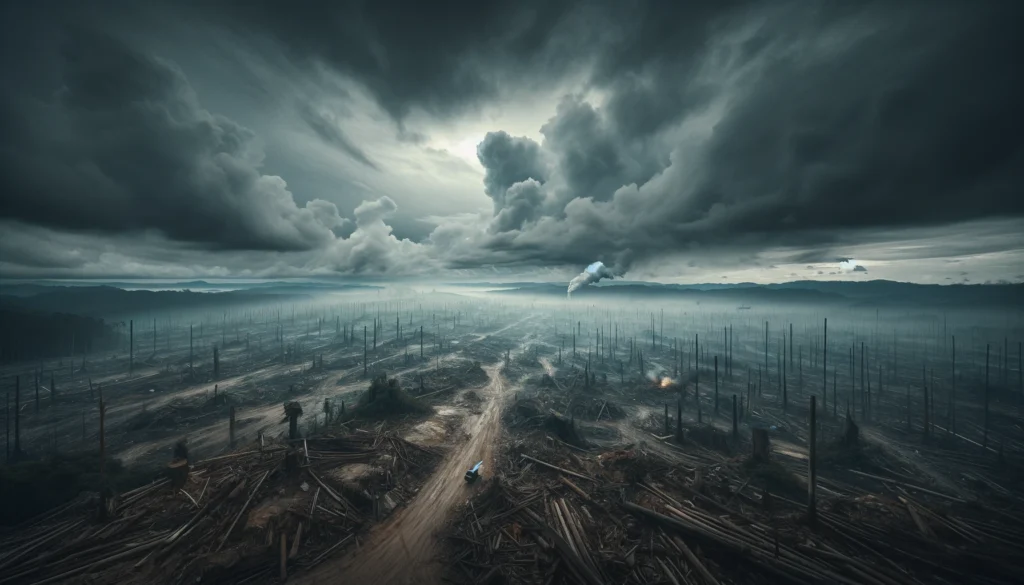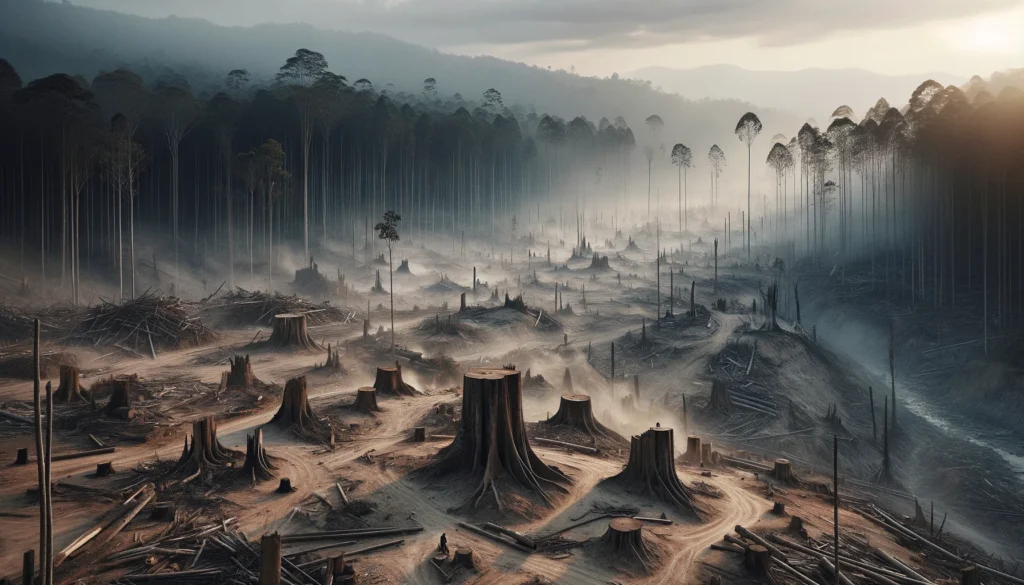Deforestation, the large-scale removal of forests, has been identified as a critical factor in climate change. While the impact of carbon emissions from burning fossil fuels is widely recognized, the role of deforestation in exacerbating climate change is equally significant. This article explores the multifaceted relationship between deforestation and climate change, highlighting its causes, consequences, and potential solutions.
Table of Contents

Causes of Deforestation
Agricultural Expansion
ne of the primary drivers of deforestation is the conversion of forested land for agricultural purposes. As global demand for commodities such as soy, palm oil, and beef continues to rise, vast areas of forests are cleared to make way for agricultural fields and pastures.
Logging
Logging, both legal and illegal, contributes to deforestation by directly removing trees for timber and wood products. Clear-cutting forests for timber extraction not only reduces forest cover but also disrupts ecosystems and biodiversity.
Infrastructure Development
The construction of roads, dams, and urban settlements often necessitates the clearing of forests. Infrastructure projects fragment habitats and degrade ecosystems, leading to loss of biodiversity and increased carbon emissions.
Mining
Mining activities, including extraction of minerals and fossil fuels, often require the clearing of forests for exploration, extraction, and transportation purposes. Mining not only directly destroys forested areas but also contributes to habitat degradation and pollution.
Consequences of Deforestation on Climate Change
Carbon Emissions
Forests act as carbon sinks, absorbing carbon dioxide from the atmosphere during photosynthesis. When forests are cleared or degraded, this stored carbon is released back into the atmosphere, contributing to greenhouse gas emissions and climate change.
Altered Weather Patterns
Deforestation can disrupt local and regional weather patterns by reducing the transpiration and evaporation that forests provide. This alteration in precipitation patterns can lead to droughts, floods, and other extreme weather events, further exacerbating the impacts of climate change.

Loss of Biodiversity
Forests harbor a significant portion of the world’s biodiversity, and deforestation leads to the loss of habitat for countless plant and animal species. The decline in biodiversity not only undermines ecosystem resilience but also disrupts crucial ecological processes that regulate the climate.
Feedback Loops
Deforestation can trigger feedback loops that amplify climate change. For example, the loss of forests in tropical regions can reduce cloud formation and precipitation, leading to drier conditions and further forest degradation.
Mitigation Strategies
Forest Conservation
Protecting and conserving existing forests is essential for mitigating climate change. Initiatives such as establishing protected areas, implementing sustainable forest management practices, and promoting reforestation and afforestation efforts can help preserve forest ecosystems and their carbon sequestration potential.
Reducing Consumption of Forest Products
Consumers can play a role in reducing deforestation by making conscious choices to support products sourced from sustainably managed forests or alternative materials that do not require deforestation.
Policy Interventions
Governments can implement policies and regulations to address deforestation, such as enforcing laws against illegal logging, incentivizing sustainable land use practices, and promoting reforestation initiatives through financial incentives and subsidies.
International Cooperation
Addressing deforestation requires coordinated efforts at the international level. Global initiatives such as REDD+ (Reducing Emissions from Deforestation and Forest Degradation) aim to provide financial incentives for forest conservation and sustainable management in developing countries.

Conclusion
Deforestation is a significant contributor to climate change, with far-reaching environmental, social, and economic consequences. Addressing deforestation requires a comprehensive approach that combines forest conservation, sustainable land management, and international cooperation. By recognizing the critical role of forests in mitigating climate change and implementing effective strategies to protect them, we can work towards a more sustainable future for our planet.
FAQs
What are the main causes of deforestation?
The primary causes of deforestation include agricultural expansion, logging, infrastructure development, and mining activities.
How does deforestation affect weather patterns and biodiversity?
Deforestation disrupts local and regional weather patterns, leading to changes in precipitation and increased frequency of extreme weather events. It also results in the loss of habitat for numerous plant and animal species, negatively impacting biodiversity.
What are some effective strategies to mitigate deforestation and its impacts on climate change?
Mitigation strategies include forest conservation, sustainable land management practices, reducing consumption of forest products, implementing policy interventions, and fostering international cooperation through initiatives like REDD+ (Reducing Emissions from Deforestation and Forest Degradation).
How can individuals contribute to combating deforestation and climate change?
Individuals can support efforts to conserve forests by making environmentally conscious choices, such as opting for sustainably sourced products, reducing consumption, and advocating for policies that promote forest conservation and sustainable land use.
You May Also Like
- CLIMATE CHANGE AND BIODIVERSITY LOSS: A THREAT TO ECOSYSTEMS
- THE ENVIRONMENTAL CONSEQUENCES OF FOSSIL FUEL EXTRACTION
- SOLAR ENERGY AND CLIMATE CHANGE: A RAY OF HOPE IN A WARMING WORLD
- THE HIDDEN COSTS OF FOSSIL FUELS: A DEEP DIVE
- WHY ESG MATTERS: EMBRACING ETHICS, SUSTAINABILITY, AND GOVERNANCE
External Links
- The Economics of Renewable Energy: A Comprehensive Cost-Benefit Analysis
- Amid climate crisis gloom, new renewables technology brings a ray of hope
- Renewable Green Energy vs Fossil Fuels: How do They Differ?
- Solar power a ray of hope for planet as carbon emissions rise
- Accelerate the Transition to 100% Renewable Energies
